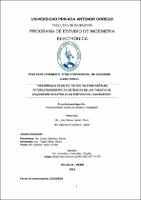Mostrar el registro sencillo del ítem
Desarrollo de un filtro digital para señales foto pletismográficas obtenidas de una tarjeta de adquisición de datos en un entorno de laboratorio
| dc.contributor.advisor | González Cadenillas, , Clayder | |
| dc.contributor.author | Lizarzaburu Bazán, Piero | |
| dc.contributor.author | Villanueva Samoluk, Javier | |
| dc.creator | Lizarzaburu Bazán, Piero | |
| dc.date.accessioned | 2023-01-19T16:33:37Z | |
| dc.date.available | 2023-01-19T16:33:37Z | |
| dc.date.issued | 2023 | |
| dc.identifier.uri | https://hdl.handle.net/20.500.12759/10140 | |
| dc.description.abstract | En la presente investigación se hizo un estudio de diversos filtros digitales que puedan cumplir con la tarea de filtrar, en tiempo real, y usando una tarjeta de adquisición de datos (TAD), señales PPG obtenidas para calcular la hemoglobina en la sangre de una persona. Es por esto que, la tarea de filtrar estas señales fotopletismográficas (PPG), es crucial, ya que un mal filtrado puede terminar en un mal cálculo de hemoglobina. El primer paso fue estudiar el estado del arte alrededor del filtrado de señales PPG y así determinar cuáles pueden ser las opciones para hacer el filtrado. Posteriormente, se obtuvieron señales PPG sin filtrar de pacientes para su estudio, lo que permitió determinar los parámetros para los filtros elegidos. Luego de ello se determinaron las ecuaciones y los algoritmos para poder hacer la comparación necesaria para la determinación del filtro. Una vez determinadas las ecuaciones y algoritmos, se procedió a hacer su implementación en PyCharm, usando el lenguaje de programación Python, lo que permitió determinar los indicadores para la comparación de los filtros y la determinación del más eficiente, es decir, que optimice los recursos computacionales disponibles sin consumo excesivo. Una vez realizada la comparación, se determinó, según las necesidades del proyecto, cuál es el filtro que cumplía los requerimientos, lo que resultó en el filtro Butterworth de orden 6. Con la determinación del filtro, se procedió a desarrollarlo en lenguaje C para luego implementarse en el microcontrolador del proyecto, validando que el filtro, funciona según los requerimientos previamente establecidos. | es_PE |
| dc.description.abstract | In the present investigation a study of many digital filters was made that may accomplish the task of filtering, in real time, and using a data acquisition board (DAQ), PPG signals obtained to calculate hemoglobin in a person’s blood. This is why, the task of filtering these PPG signals, is crucial, because, a bad filtering, may result in a bad hemoglobin calculation. The first step was studying the state of art surrounding photoplethysmographic signal (PPG) filtering, that way, determining which options may do the filtering task. After that, unfiltered PPG signals were obtained from patients, for its study, that way, the parameters needed, could be determined for the study of the chosen filters. After that, the equations and algorithms needed were determined for making the comparison for the filter determination. Once the equations and algorithms needed were determined, the implementation in PyCharm was done, using Python programming language, which allowed us to determine the indicators for the filter’s comparison and the determination of the most efficient one, that it optimizes the available computational resources without excessive consumption. When the comparative table was done, it was determined that, following the project needs, the most adequate filter, turned to be order 6 Butterworth filter. With this result, it was developed the filter in C language so it could be implemented in the microprocessor of the project, validating that this filter, works according to the previously established requirements. | en_US |
| dc.description.uri | Tesis | es_PE |
| dc.format | application/pdf | es_PE |
| dc.language.iso | spa | es_PE |
| dc.publisher | Universidad Privada Antenor Orrego | es_PE |
| dc.relation.ispartofseries | T_ELECT_879 | |
| dc.rights | info:eu-repo/semantics/openAccess | es_PE |
| dc.rights.uri | https://creativecommons.org/licenses/by/4.0/ | es_PE |
| dc.source | Universidad Privada Antenor Orrego | es_PE |
| dc.source | Repositorio Institucional - UPAO | es_PE |
| dc.subject | Filtros | es_PE |
| dc.subject | Señales | es_PE |
| dc.title | Desarrollo de un filtro digital para señales foto pletismográficas obtenidas de una tarjeta de adquisición de datos en un entorno de laboratorio | es_PE |
| dc.type | info:eu-repo/semantics/bachelorThesis | es_PE |
| thesis.degree.level | Título Profesional | es_PE |
| thesis.degree.grantor | Universidad Privada Antenor Orrego. Facultad de Ingeniería | es_PE |
| thesis.degree.name | Ingeniero Electrónico | es_PE |
| thesis.degree.discipline | Ingeniería Electrónica | es_PE |
| dc.subject.ocde | https://purl.org/pe-repo/ocde/ford#2.11.00 | es_PE |
| renati.advisor.orcid | https://orcid.org/0000-0002-6777-4479 | es_PE |
| renati.author.dni | 76344364 | |
| renati.author.dni | 74163148 | |
| renati.advisor.dni | 44565065 | |
| renati.type | https://purl.org/pe-repo/renati/type#tesis | es_PE |
| renati.level | https://purl.org/pe-repo/renati/level#tituloProfesional | es_PE |
| renati.discipline | 712026 | es_PE |
| renati.juror | Cerna Sánchez, Elmer | |
| renati.juror | Trujillo Silva, Marco | |
| renati.juror | Ramos Rojas, Ovidio | |
| dc.publisher.country | PE | es_PE |
Ficheros en el ítem
Este ítem aparece en la(s) siguiente(s) colección(es)
-
Ingeniería Electrónica [146]


